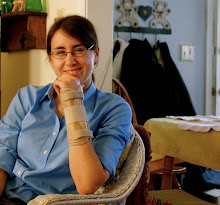~~*
~~
The
enduring power of architectural landmarks stems from the stories they
recall, as well as the emotions they evoke in the viewer. From the
Brooklyn Promenade in New York, the casual observer can see such
icons as the Statue of Liberty, as well as the still-noted absence of
the World Trade Center towers, whose monuments are even now starting
to rise from the dust. These structures are clear examples of places
with stories and with emotions, but they are not alone in this
category on the Lower Manhattan skyline. They are joined by the
equally impressive and perhaps even more unique Brooklyn Bridge.
Before
the bridge became a design and then a reality, the East River was an
obstacle inhibiting passage between the two separate, growing cities
of Brooklyn and Manhattan. Then as now, residents were wont to live
in Brooklyn and work in Manhattan, but the only way to cross between
the two cities was by slow, crowded, and unsafe ferries. Ice in the
winter could halt all passage, and high winds could send the boats
aground. These circumstances made the so-called “Great Bridge” a
much-needed project.
The
problem lay in the river itself, and in the capacity of contemporary
engineering to conquer it. Historian David McCullough writes in his
book The
Great Bridge that,
“the East River...is no river at all technically speaking, but a
tidal strait and, in that day, especially, one of the busiest
stretches of navigable salt water anywhere on earth” (24). There
was no hope of supporting the bridge in the center of the river; it
required a single arc stretching between Brooklyn and Manhattan.
Enter
the engineers. John Roebling had pioneered construction of suspension
bridges in Pittsburgh, Niagara Falls, and Cincinnati; his son,
Colonel Washington Roebling, worked with his father on these
projects, serving as both confidant and co-engineer. These bridges
separately formed the core of the Great Bridge in Brooklyn, an
efficient design that allowed for the crossing of a near-impassable
body of water.
The
design principle of the suspension bridge worked better for the
Brooklyn Bridge than any other design could have. Suspension bridges
are capable of spanning up to 7,000 feet through the use of
compression
and
tension.
Two towers are embedded in the earth to support the majority of the
deck's weight; cables are strung to hold tension as they are
stretched taut between two anchorages. The cables are able to
transfer the pressure (compression) of the deck to the towers and
then directly into the earth. (For more on suspension bridges, check
out http://static.howstuffworks.com/pdf/ups-suspension-bridge.pdf
)
The
bridge would cost the Roeblings dearly-- indeed, it turned out that
John Roebling's legacy would be as the bridge's designer; an accident
at the work site and its subsequent surgery went bad and killed him.
Washington Roebling served as the bridge's chief engineer until its
completion, though it impacted his health negatively too.
The
Great Bridge also made use of the most recent technology in its
construction. This was particularly true of the caissons that were to
support the towers, which had to be sunk in the river and work be
conducted inside to permanently embed them in the stone at the bottom
of the river. Weight on top, compressed air inside, and excavation of
the riverbed would all help to push these great structures to a
stable position at the bedrock, where they would be filled with
concrete.
This
simple concept, however, became a more complicated reality when they
had to adapt the workers to such starkly different levels of air
pressure. This situation lead to the ailment that we now know as “the
bends,” sharp pain in the joints that appeared among workers coming
out of the caissons, and was first identified during the work on the
Eads Bridge in St. Louis. In some cases, both in St. Louis and in
Brooklyn, the disease would cause paralysis or even death. Among
these statistics was Washington Roebling himself, who was paralyzed
by an attack of “the bends” in 1872, and ultimately had to
oversee the final construction of the bridge from his house near what
is now the Brooklyn Promenade.
The
bridge's tall granite towers and proud arches dominated views of
Lower Manhattan when it opened in 1883. Though it no longer claims
that distinction today, it still represents the stories of the men
who designed it and the men who built it, as well as the use of
modern science to overcome the adversity of nature to human progress.
By linking two previously separate cities together, the Brooklyn
Bridge represents the most practical of monuments, one that provides
a spectacle for the eye, an experience for the tourist, and a
functional transportation option for all who would pass over it.

No comments:
Post a Comment